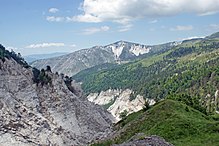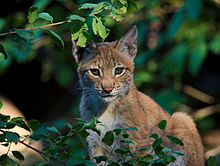Central Mountain Region (Albania)

The Central Mountain Region (
The central mountain range can be conventionally divided into a number of subregions. The north encompasses the mountainous districts of
The relief of the central mountain range is varied and supplied with high
The
Geology
Korab Mountains

The
The Korab massif is the fourth

Korab is renowned for its 39
Jabllanicë and Shebenik Mountains

The
The mountains are the source of the name of the
still survives in the mountains.Valamara Mountains

The Valamara Mountains lies between the Shkumbin valley in the north and Devoll valley in the south. Moreover, the Shkumbin river originates in the mountains.[14] The mountains are situated on the territory of three districts such as Gramsh, Pogradec and Korçë. The summit of the Valamara range in southwestern Albania, Maja e Valamarës is the highest peak with an elevation 2,373 metres (7,785 ft).[citation needed] They are formed of Mesozoic and Paleozoic sedimentary rocks of dolomite, limestone, sand and conglomerates formed by seas and lakes that had once covered the area. In addition to that, several glacial lakes can be found on the eastern part. The total length of the Valamarians is over 13 km (8 mi) and the mountain chain's width varies between 10 and 15 km (6 and 9 mi). The highest altitudes occur where they are widest.
Skanderbeg Mountains

The Skanderbeg Mountains (
The northern section south of
Hydrology
The hydrography of the central mountain range is dominated by glacial lakes and a dense network of streams that temporary flow in periods of snow or rain melt. With a total length of 285 km (177 mi), the Drin river is the longest and largest in the region. As the river flows through the karstic regions of the mountains and hills, its banks are steep with cliffs and precipices. The region belongs mainly to the
In the southeast, the
Biology

Flora
The central mountain range contains extraordinary biological diversity and a vast array of
The
Fauna
The
.The central mountain range provide exceptional watching opportunities for
The area of
See also
- Korab-Koritnik Nature Park
- Lurë National Park
- Mali me Gropa-Bizë-Martanesh Protected Landscape
- Ohrid-Prespa Biosphere Reserve
- Prespa Ramsar Site
- Rajcë Nature Reserve
- Rajcë part of Primeval beech forests of the Carpathians and other regions of Europe
- Shebenik-Jabllanice National Park
- Zall-Gjoçaj National Park
References
- ^ "Udhezimi nr.2 date 20.07.2016" (PDF). mjedisi.gov.al (in Albanian). p. 1. Archived from the original (PDF) on 2017-09-07. Retrieved 2017-09-07.
- ISBN 9789995610326.
- ^ University of Tirana. "TURIZMI NË RRETHIN E DIBRËS" (PDF). doktoratura.unitir.edu.al. p. 21. Archived from the original (PDF) on 2017-10-08. Retrieved 2017-10-08.
- ^ European Green Belt. "Brezi i Gjelbër Evropian" (PDF). europeangreenbelt.org (in Albanian). p. 2. Archived from the original (PDF) on 2015-10-18. Retrieved 2017-09-10.
- ^ Ramsar Convention (3 July 2013). "Albania adds its parts of the Prespa Lakes to the Ramsar List". ramsar.org.
- ^ "The King of the Mountains" (PDF). dmwcorg.tk. p. 1. Archived from the original (PDF) on 2019-04-02. Retrieved 2017-09-07.
- ^ "Natural and anthropogenic hazards in karst areas of Albania" (PDF). nat-hazards-earth-syst-sci.net. p. 6.
- ^ "The King of the Mountains" (PDF). dmwcorg.tk. p. 24. Archived from the original (PDF) on 2019-04-02. Retrieved 2017-09-07.
At 2764 meters Korab peak is one of only two summits in Europe which are the highest point for more than one country.
- ^ "EUROPE ULTRA-PROMINENCES 99 Peaks with Prominence of 1,500 meters or greater". peaklist.org.
- ^ "FEASIBILITY STUDY ON ESTABLISHING A TRANSBOUNDARY PROTECTED AREA SHARR/ŠAR PLANINA – KORAB – DEŠAT/DESHAT" (PDF). envsec.org. p. 54. Archived from the original (PDF) on 2017-09-07. Retrieved 2017-09-07.
- ^ European Green Belt. "Balkan Green Belt as Ecological Corridor for Wolf, Bear and Lynx". europeangreenbelt.org. Archived from the original on 2018-06-12. Retrieved 2017-09-10.
- ^ "FEASIBILITY STUDY ON ESTABLISHING A TRANSBOUNDARY PROTECTED AREA SHARR/ŠAR PLANINA – KORAB – DEŠAT/DESHAT" (PDF). envsec.org. p. 4. Archived from the original (PDF) on 2017-09-07. Retrieved 2017-09-07.
- ^ "Vendim Nr. 640 (21. Mai 2008): Për shpalljen "Park kombëtar" të ekosistemit natyror Shebenik-Jabllanicë" (PDF). mjedisi.gov.al (in Albanian). p. 1. Archived from the original (PDF) on 2014-12-10. Retrieved 2017-09-08.
- ^ "GIS Technology on Natural Disasters Management in Albania" (PDF). ijsr.net. p. 3.
- ^ Vergmalet e Skënderbeut (Academy of Sciences of Albania ed.). Tirana. 1991. pp. 171–191.
{{cite book}}: CS1 maint: location missing publisher (link) - ^ Albanien. Eine Landeskunde vornehmlich auf grund eigener Reisen (Herbert Louis ed.). Berlin. 1927.
{{cite book}}: CS1 maint: location missing publisher (link) - ^ "ANALIZA E THELLUAR DHE VLERËSIMI I GJENDJES EKZISTUESE TË TERRITORIT" (PDF). vaudejes.gov.al. p. 55.
- ^ "Përmirësimi i aksesit rrugor Lezhë - Velë për gjenerimin e aktiviteteve turistike të një spektri të gjerë" (PDF). km.dldp.al (in Albanian). p. 1. Archived from the original (PDF) on 2017-09-13. Retrieved 2017-09-13.
- ISBN 9783319477329.
- ^ "HYDROLOGY OF THE TRANSBOUNDARY DRIN RIVER BASIN" (PDF). ce.utexas.edu. p. 3.
- ^ "Internationally Shared Surface Water Bodies in the Balkan Region". inweb.gr.
- ^ "Analysis of bridge foundation damage in Albania" (PDF). ac.els-cdn.com. p. 3.[permanent dead link]
- ^ "SILVER FIR (ABIES ALBA) RESOURCES IN ALBANIA AND THEIR CONSERVATION". fao.org.
- ^ "State of Forest Tree Genetic Resources in Albania" (PDF). fao.org. p. 7.
- ^ "Black pine (Pinus nigra Arn.) resources in Albania[35] (M.Dida[36], F. Ducci[37] and G. Zeneli2)". fao.org.
- ^ "Balkan Lynx Conservation". fightingforhope.wordpress.com. 9 August 2013.
{{cite web}}: Missing or empty|url=(help) - ^ "Korab - Koritnik Natural Park Management Plan" (PDF). researchgate.net. p. 41.
- ^ SLOTTA-BACHMAYR L., BÖGEL R. & CAMINA CARDENAL, A. (2005). "The Eurasian Griffon Vulture (Gyps fulvus) in Europe and the Mediterranean" (PDF). researchgate.net. p. 23.
{{cite web}}: CS1 maint: multiple names: authors list (link) - ^ Ramsar Convention. "The Annotated Ramsar List: Albania". archive.ramsar.org. p. 1. Archived from the original on 2017-09-14. Retrieved 2018-09-10.
- ^ Euronatur. "Balkan lynx verified in Shebenik-Jablanica National Park". euronatur.org. Archived from the original (PDF) on 2021-09-20. Retrieved 2017-09-11.
